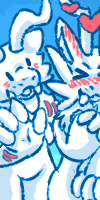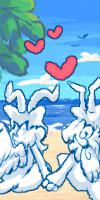Courtship is an informal ceremonial bond between two Isomara, leading to offspring development. The act of courting often starts with introductions and the building of the couple's relationship. Isomara couples will go on dates to get to know each other, then gift precious gem trinkets, and finally share a space for a nest and the arrival of Isomara eggs.
It is common for Isomara to have multiple mates over their lifetime. Isomara regularly choose mates based on strong bonds, and some only court other Isomara who are skilled and well-trained.
Once they have built up their relationship, each Isomara will search for a precious gem to give to the other to cherish. They will then work together to build a nest for the planned upcoming egg(s).
General Courtship Information
- Players may submit an unlimited number of courtships per month
- Each Isomara can court only once a month
- Only adult Isomara can participate in courtship
- Isomara suffering from an Infliction or Ailment will not be able to court
- Isomara who appear in each other's lineage or relations lists on a master list page cannot court together
- Courtship items such as gems and nests can only be used once. Once used, the items will be removed from the owner's inventories.
- Each Isomara pair will only produce one egg, unless the two Isomara have different owners. If that is the case, then two eggs will be laid. Each owner will receive one egg from the courtship, assigned at random.
- Fertility Wax can be used to produce two eggs instead of one if you own both Isomara in the courtship
Passing Down Traits
When all courtship prompts are complete, the egg(s) will be designed and an official master list page will be uploaded. Eggs are designed by staff, but the colors, markings, and traits are not decided by staff and instead are randomly rolled based on lineage and other item factors.![]()
Traits
Only certain traits will be noticeable when eggs are laid. Noticeable traits on eggs include the special traits: Dim Primary, No Scent, and Radiant. All other traits will not be known until the egg is hatched. All other traits are passed down depending on the parents' traits, which is explained more in hatching an Isomara egg.
TIP: Using a Prisma Diamond guarantees the offspring will have at least one random special trait, and a Luminous Nest increases the chance for eggs to have the Radiant special trait.
Design
The color and markings of an egg's design are rolled separately. An egg can have a combination of colors from the last two generations (parents and grandparents) or random colors. The same goes for the markings on the eggs, where markings can be passed on from parents, grandparents or be completely random. The colors and markings may not always be identical to any parent, and may be altered slightly during the design phase by staff.
Egg Design Breakdown - Colors & Markings - Click to Reveal
For those who want further information on how colors and markings for eggs are decided in a courtship continue to read below, otherwise avert your eyes!
Rolling for Colors:
An isomara eggs colors can be passed down from either parent, grandparents, or be completely random. For the colors to be decided first two rolls are conducted with seven possible outcomes. These seven outcomes are:
- (1) Parent A, (2) Parent B, (3) Grandparent AA, (4) Grandparent AB, (5) Grandparent BA, (6) Grandparent BB, and (7) random
These two rolls are to find which combination of the lineage the egg will take its colors from. The total colors from both outcomes will be calculated and a roll with that number as the max outcome will be conducted. This roll decides how many colors the egg will have (Note: to prevent many plain eggs if 1, 2, or 3 is rolled we roll the max color outcome again and take the higher number from these two rolls). This new value is then used to roll against the total colors from the previous steps to decide which colors will make up the egg's palette.
Summary & Example:
- Roll 2d7 to find which combo of the lineage the egg will inherit its colors from
- Grandparent AA and Parent B are rolled
- Roll 1dX (X = Sum of colors from the two rolled in step 1) to decide how many colors the egg will have (If 1, 2, or 3 is rolled roll 1dX again. Take the higher number of the rolls). Number of colors will be "Y"
- Grandparent AA has 4 colors and Parent B has 7 colors, totaling 11 colors. X=11
- After rolling 1d11 (1dX) we find the egg will have 8 total colors. Y=8
- Roll 8d11 (YdX) to discover the egg's palette
- With Grandparent AA's palette and Parent B's palette lined up let's say 2 of Grandparent AA's colors were rolled and 6 of Parent B's colors were rolled.
Notes:
- Whites and Dyed White special trait colors are not a part of the total sum of colors available to choose from during step 2 as white is seen as a free color that can be added when designing the hatched isoling and dyed whites (birth) are mutations that does not normally pass through inherited genetics.
- If in step 1 a lineage is rolled that does not exist it defaults to random. For random a palette of 4 colors is randomly generated (this palette will never include dim primary color ranges)
- For any isomara with dim primary their colors if rolled to pass to the egg will be alter to the closest hue/saturation that doesnt fall under dim primary if the egg did not roll the dim primary trait (these special birth traits are rolled prior to colors/markings)
Rolling for Markings:
Marking inheritance is similar to color where two rolls are conducted with seven possible outcomes. These seven outcomes are:
- (1) Parent A, (2) Parent B, (3) Grandparent AA, (4) Grandparent AB, (5) Grandparent BA, (6) Grandparent BB, and (7) random
From there though staff freely allow artistic freedom to overcome them and inspire them to implement marking from those two rolled outcomes. At times staff may choose to alter or even include new markings outside of the rolls as well.
Courtship Steps
Step 1 - Come a little closer
When two isomara aim to court one another, they get to know each other by going on dates. Dates are planned arrangements in which the Isomara go to spend time together. These dates can be anywhere from a fishing trip to having a meal, sharing each other's company in a particular spot, etc.
Step 1 involves creating artwork or writing stories of your isomara going on dates to get to know and bond with the other isomara involved in the courtship.
|
|
Date #1 - First EncountersTwo isomara often unknowingly go on their first date. This could be a group get-together with friends, a random encounter with each other during an evening run, etc. Display/describe what their first date looked like. Date #2 - A Rendezvous For TwoThe second date is meant to be a bit more private. Just the two isomara involved in the courting getting to know each other, building their bond and love for one another. Display/describe what their second date looked like, what did they do, and where did they go? |
Date Guidelines
- When courting two Isomara, you own both date prompts must be completed
- If courting an Isomara owned by you and another person, each person needs to complete one of the date prompts.
- Person A completes Date #1 & Person B completes Date #2
- You may collaborate on the dates, allowing both parties to share the workload of completing both date prompts
- Art must include both Isomara, at least 50% visible, colored, and have at least a simple background
- Literature must be at least 500 words long
- You may do “AU” or Alternate Universe versions of your Isomara for dates
- Ex. Draw both of your Isomaras as anthropomorphic or human going to the movies or at a fancy restaurant as if they lived in our world is completely allowed!
- Dates cannot double as explorations, trainings, or any other activity, prompt, or event entry.
Step 2 - Gems, nests, & Other Items
Once the two isomara are familiar with each other, they will go search for a precious gem to gift each other. When each has their gift and exchanges it, they will remain together and make a nest. Gathering and gifting precious gems is a long-held tradition that tells a lot about an isomara. It shows their work ethic and devotion to each other. The type of gem can represent their favorite color, a reminder of their partner, or some abstract hope or meaning.
Courtship Item Guidelines
To use items in a courtship, attach the items as add-ons to the Date #2 - A Rendezvous For Two prompt when submitting.
- Two gems are needed per courtship. Gems acceptable for courting are Amethyst, Emerald, Ruby, Sapphire, Topaz, and Prisma Diamonds.
- Using a Prisma Diamond in a courtship guarantees all eggs/isolings will have at least one random special trait.
- Normal Diamonds cannot be used in courtships.
- Nests are craftable items that can only be used once per courtship. Luminous Nests will increase the chance for eggs to have the Radiant special trait compared to the Normal Nest.
- Fertility Wax can be used by a player courting two of their own Isomara to produce two eggs instead of one.


